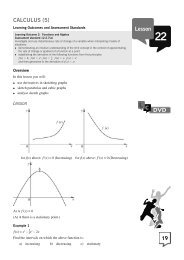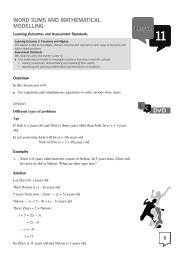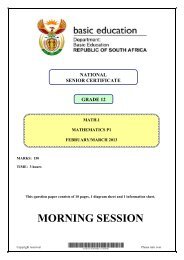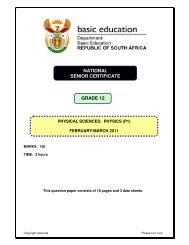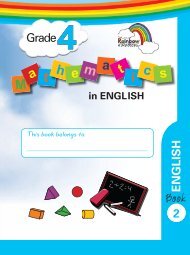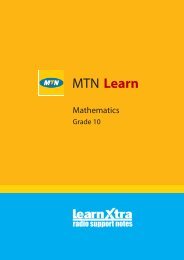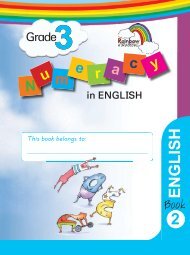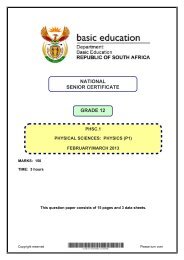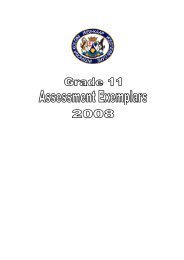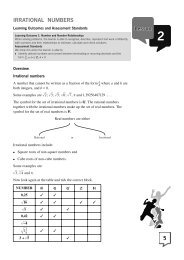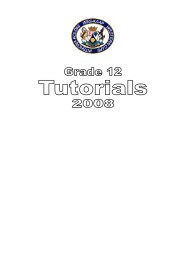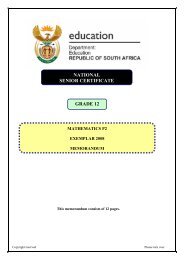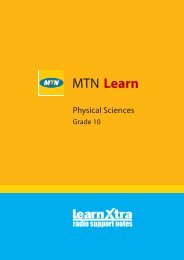Teacher's Guide Module 1 - Maths Excellence
Teacher's Guide Module 1 - Maths Excellence
Teacher's Guide Module 1 - Maths Excellence
Create successful ePaper yourself
Turn your PDF publications into a flip-book with our unique Google optimized e-Paper software.
The knowledge and skills are reflected in the Learning Outcomes, as indicated in the table<br />
below.<br />
LO1<br />
LO 2<br />
LO 3<br />
LO 4<br />
LO 5<br />
Learning Outcomes<br />
Numbers, operations and<br />
relationships<br />
To be able to recognize, describe<br />
and represent numbers and their<br />
relationships and to count, estimate,<br />
calculate and check with<br />
competence and confidence in<br />
solving problems<br />
Patterns, functions and algebra<br />
To be able to recognize, describe<br />
and represent patterns and<br />
relationships, as well as to solve<br />
problems using algebraic language<br />
and skills<br />
Space and Shape (Geometry)<br />
To be able to describe and<br />
represent characteristics and<br />
relationships between twodimensional<br />
shapes and threedimensional<br />
shapes in a variety of<br />
orientations and positions<br />
Measurement<br />
To be able to use appropriate<br />
measuring units, instruments and<br />
formulae in a variety of contexts<br />
Data handling<br />
To be able to collect, summarize,<br />
display and critically analyse data in<br />
order to draw conclusions and make<br />
predictions, and to determine<br />
chance variation<br />
Main focus in each outcome<br />
The learner moves from counting<br />
correctly to calculating with all four<br />
operations; learns to use the calculator<br />
as an effective tool as and when it’s<br />
needed; knows tables to 12 x 12 and can<br />
calculate mentally effectively.<br />
Numeric and geometric patterns are<br />
studied, especially the relationships<br />
between the terms in a sequence and<br />
between the number of a term and the<br />
term itself.<br />
The learner deals with a more detailed<br />
description of 2D shapes and 3D objects.<br />
Learners use standardized units of<br />
measurement and measuring<br />
instruments and must be able to estimate<br />
and prove results through accurate<br />
measurement.<br />
Learners gain skills in gathering and<br />
summarising data so that the data can<br />
be interpreted and used to make<br />
predictions.<br />
ASSESSMENT STANDARDS<br />
The assessment standards are closely related. Activities should, wherever possible, cover<br />
more than one assessment standard within one learning outcome. Activities may cover<br />
related Assessment Standards across Learning Outcomes within the grade.<br />
LEARNER ASSESSMENT<br />
At the end of each activity there is an assessment sheet. Both the learner and the educator<br />
complete this. The assessment of both may then be compared. The educator’s assessment<br />
will serve to provide marks for the portfolio.<br />
CODES FOR ASSESSMENT SHEETS<br />
4 = Learner’s performance has exceeded the requirements of the learning outcome for the<br />
grade.



